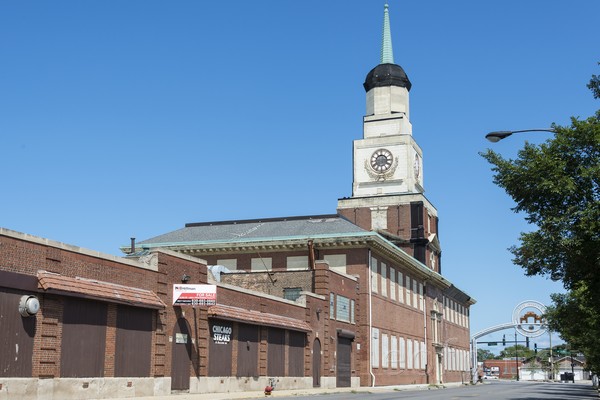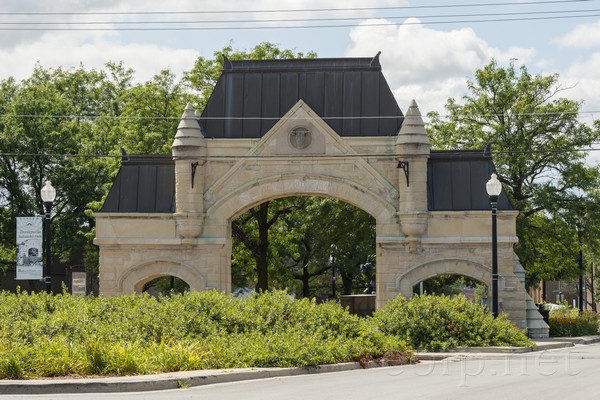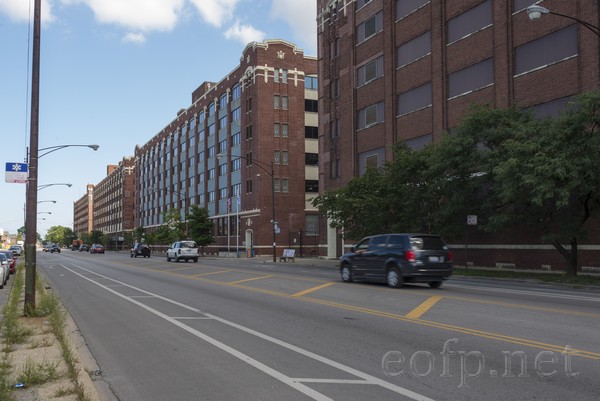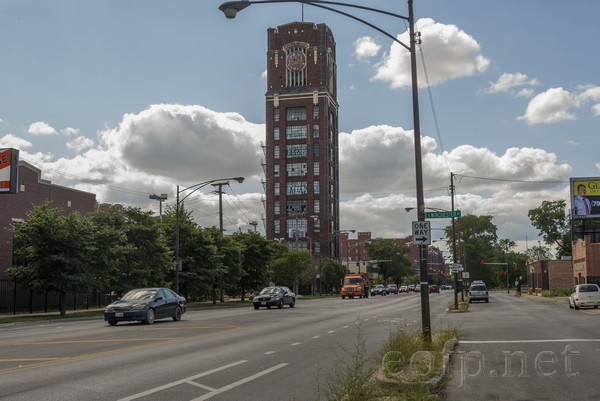Chicago Illinois
9/25/2017Union Stockyards, Chicago
There are a multitude of interesting places in Chicago. I can only begin to scratch the surface here. I visited the city in 2017 and was able to stop at just a few. On this page I have a couple photos of the Union Stockyards and the Central Manufacturing District. I've made a separate page for Pullman here. I have some photos I took in Chicago in the late 1980s, many of buildings that have since been demolished, here.
The Union Stockyards, on the near Southwest side, was once one of the most popular tourist attractions in the city. The Stockyards were a vast area of rail connected livestock enclosures surrounded by slaughterhouses. The stench, the dust, and the noise must have been awful. William Cronon wrote a great history of the stockyards in Nature's Metropolis. It's hard for me to understand why anyone would have wanted to visit the Stockyards as a tourist but people came in droves. A visit to the Union Stockyards was on the itinerary of many visitors to the 1893 Chicago Worlds Fair. Hundreds of souvenir books were printed about the stockyards and millions were sold. I have one that was printed in 1901 full of glowing descriptions, illustrations, and gripping anecdotes. It was partly because of their fame that Upton Sinclair chose the stockyards as the setting for his 1905 novel The Jungle. Sinclair intended to call attention to the deplorable working conditions of industrial workers, in general, with The Jungle. Instead it shocked Americans with its description of the horrible food handling practices in the new industrial scale meat packing companies. This triggered a wave of activism that led to the Federal Meat Inspection Act. Sympathy for the slaughterhouse workers had less of an impact. The Union Stockyards operated from 1865 to 1971. The stockyards were surrounded by a larger industrial district which contained some unrelated industries, many cold storage and other warehouses in addition to meat processing plants. This area is still referred to as the stockyards district. Today, hardly anything is left of the stockyards and what survives is rarely visited. The stockyard's gate (below) and the boarded up Stockyards National Bank (above) are two of the most visible survivors. When I lived in Chicago in the late 1980s, the Stockyards district was still scattered with massive, multistory, abandoned cold storage warehouses and the shells of other former industrial buildings. I spent countless days and hours climbing around the ruins. I've put some surviving photos of that era here. Most of those buildings have been demolished by now. They have generally been replaced with modern low-rise industrial buildings, some with the lawns and parking lots that are found in suburban office parks. There are still a few older structures, though, scattered around. Just west of the stockyards is the Back of the Yards district. This is where the characters in Sinclair's book would have lived. Jane Jacobs discusses Back of the Yards several times in The Death and Life of Great American Cities. She points to the neighborhood as a successful example community organizing. The most famous Back of the Yards organizer was Saul Alinsky who inspired a generation of activists. Back of the Yards is still a diverse, blue collar neighborhood that teams with activity.
Union Stockyards, Chicago
The Central Manufacturing District is interesting to me for a number of reasons. Its shear size, the monotonous bulk of its buildings, make it an impressive sight. It always evoked for me the kind of dystopian vision of the future seen in movies and fiction of the early 1900s like Metropolis. The construction of the Central Manufacturing District (CDM) started in 1905. The surviving CMD buildings stretch for almost a mile along Pershing road. They are an intimidating, almost unbroken wall, of nearly identical, six story buildings. It is one of the largest speculative loft industrial developments ever built in the United States. I don't know of any other its' size. The construction of speculative loft buildings for industrial use gained popularity in the late 1800s. Buildings were constructed to be as versatile as possible and space was leased to small or large industrial users. The buildings were financed by banks and investors. This practice was especially popular in New York City and with certain industries like the garment industry. The versatility of the buildings made them easy to convert to residential use. The trend of converting these loft buildings to condominiums, that started in the late 70s and 80s, has changed the meaning of loft and loft building for many. The CMD though is not in a gentrifying area of Chicago and it is way too large to be easily converted to other uses. So it sits, mostly empty today. The CMD's 12 story clock tower housed the water tank for the district's advanced (for the time) fire suppression system. Efforts to lease and use the CMD's many buildings are on-going. Some buildings seem to be fully used while others are no longer being maintained.
Central Manufacturing District, Chicago
Central Manufacturing District, Chicago
All content on these pages Copyright Mark Hedlund 2012-2019. All rights reserved. Use in school projects and with links on social media is always okay. Please send me an email to request permission for any other use: hedlunch@yahoo.com Non-exclusive commercial publication rights for most photos is $25 per image.




